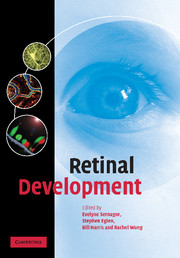Book contents
- Frontmatter
- Contents
- List of contributors
- Foreword
- Preface
- Acknowledgements
- 1 Introduction – from eye field to eyesight
- 2 Formation of the eye field
- 3 Retinal neurogenesis
- 4 Cell migration
- 5 Cell determination
- 6 Neurotransmitters and neurotrophins
- 7 Comparison of development of the primate fovea centralis with peripheral retina
- 8 Optic nerve formation
- 9 Glial cells in the developing retina
- 10 Retinal mosaics
- 11 Programmed cell death
- 12 Dendritic growth
- 13 Synaptogenesis and early neural activity
- 14 Emergence of light responses
- New perspectives
- Index
- Plate section
- References
7 - Comparison of development of the primate fovea centralis with peripheral retina
Published online by Cambridge University Press: 22 August 2009
- Frontmatter
- Contents
- List of contributors
- Foreword
- Preface
- Acknowledgements
- 1 Introduction – from eye field to eyesight
- 2 Formation of the eye field
- 3 Retinal neurogenesis
- 4 Cell migration
- 5 Cell determination
- 6 Neurotransmitters and neurotrophins
- 7 Comparison of development of the primate fovea centralis with peripheral retina
- 8 Optic nerve formation
- 9 Glial cells in the developing retina
- 10 Retinal mosaics
- 11 Programmed cell death
- 12 Dendritic growth
- 13 Synaptogenesis and early neural activity
- 14 Emergence of light responses
- New perspectives
- Index
- Plate section
- References
Summary
Introduction
The macula lutea (‘yellow spot’), located towards the posterior pole of the human retina was identified grossly in the late eighteenth century, and the fovea centralis – located approximately at the centre of the macula – was first described by Soemmerring in 1795. It was H. Müller who produced the first histological description of the human fovea (see Polyak, 1941), along with identification of the retinal layers and a correct analysis of their general place in the retinal circuitry. Knowledge of its anatomical organization was greatly expanded by the Golgi impregnation work of Cajal (1893) and Polyak (1941), which indicated that foveal cones give rise to highly specialized circuits.
Some of the earliest studies of developing primate retina were carried out by Chievitz (1888), Magitot (1910) and Bach and Seefelder (1911, 1912, 1914), from whose work some illustrations are reproduced later in this chapter. These early studies were greatly expanded on by Ida Mann in the first part of the twentieth century and published in monograph form in 1928 (see Mann, 1964, 2nd edition). Little further work was published on foveal development until Hendrickson and Kupfer's study (1976) showing photoreceptor displacement towards the developing fovea. This most recent period of analysis of primate (including human) retinal development (1976 to present) has taken place in the context of an expanding body of knowledge, gleaned largely from investigation of retinal development in non-primate species – much of which is covered in other chapters of this volume – including gene regulation of eye and retinal formation, retinal cell generation, development of target visual nuclei, guidance mechanisms, the importance of neuronal acitivity and the significance of apoptosis.
- Type
- Chapter
- Information
- Retinal Development , pp. 126 - 149Publisher: Cambridge University PressPrint publication year: 2006
References
- 7
- Cited by



